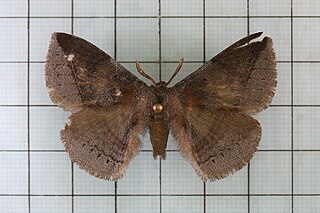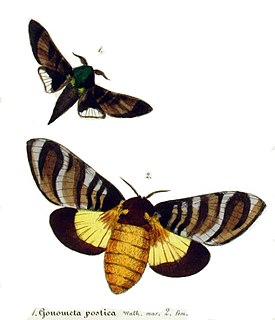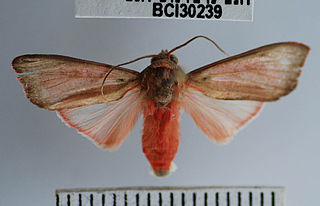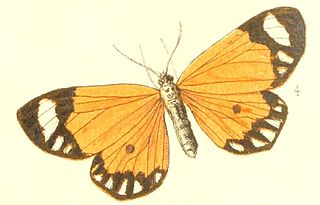
Melese is a genus of moths in the family Erebidae. The genus was erected by Francis Walker in 1854.
Pompiliodes is a genus of moths in the subfamily Arctiinae. The genus was erected by George Hampson in 1898.

Pseudosphex is a genus of tiger moths in the family Erebidae. The genus was erected by Jacob Hübner in 1818. These moths are mimics of a variety of Hymenoptera. The prefix pseudo means "false", and Sphex is a genus of wasps.

Mimeusemia is a genus of moths of the family Noctuidae first described by Arthur Gardiner Butler in 1875. Species are found in Japan, India, Sri Lanka and Myanmar.

Cyllopoda is a genus of moths in the family Geometridae.

Ganisa is a genus of moths of the family Eupterotidae first described by Francis Walker in 1855.

Ganisa postica is a moth of the family Eupterotidae described by Francis Walker in 1855. It is found in India, Myanmar, Sri Lanka and Taiwan.

Orgyia postica, the cocoa tussock moth or hevea tussock moth, is a species of moth of the subfamily Lymantriinae of family Erebidae found from the Oriental tropics of India, Sri Lanka, Myanmar, Borneo, Java, New Guinea and Taiwan. It was described by Francis Walker in 1855.

Gonometa postica, known commonly as the African wild silk moth, burn worm, and brandwurm, is a large species of African moth belonging to the family Lasiocampidae. The genus Gonometa boasts some very large moths and larvae; Gonometa sjostedti from Africa has a larva 16 centimeters long, for example. Most of the Lasiocampidae are highly sexually dimorphic. In G. postica the forewing of the male measures 21–25 mm and of the female 35–42 mm.

Anthela is a genus of moths of the family Anthelidae. The genus was erected by Francis Walker in 1855.
Melese babosa is a moth of the family Erebidae. It was described by Paul Dognin in 1894. It is found in Brazil and Ecuador.
Melese binotata is a moth of the family Erebidae. It was described by Francis Walker in 1856. It is found in Brazil.

Melese incertus is a moth of the family Erebidae. It was described by Francis Walker in 1855. It is found in French Guiana, Suriname, Guyana, Brazil, Venezuela, Trinidad, Peru, Bolivia and Panama.
Melese innocua is a moth of the family Erebidae. It was described by Paul Dognin in 1911. It is found in Colombia.
Melese paranensis is a moth of the family Erebidae. It was described by Paul Dognin in 1911. It is found in Argentina.
Pseudosphex postica is a moth of the subfamily Arctiinae. It was described by Francis Walker in 1854. It is found in the Amazon region.
Pompiliodes postica is a moth in the subfamily Arctiinae. It was described by Francis Walker in 1856. It is found in Panama and the Amazon region.

Mimaletis postica is a moth in the family of Geometridae first described by Francis Walker in 1869.









